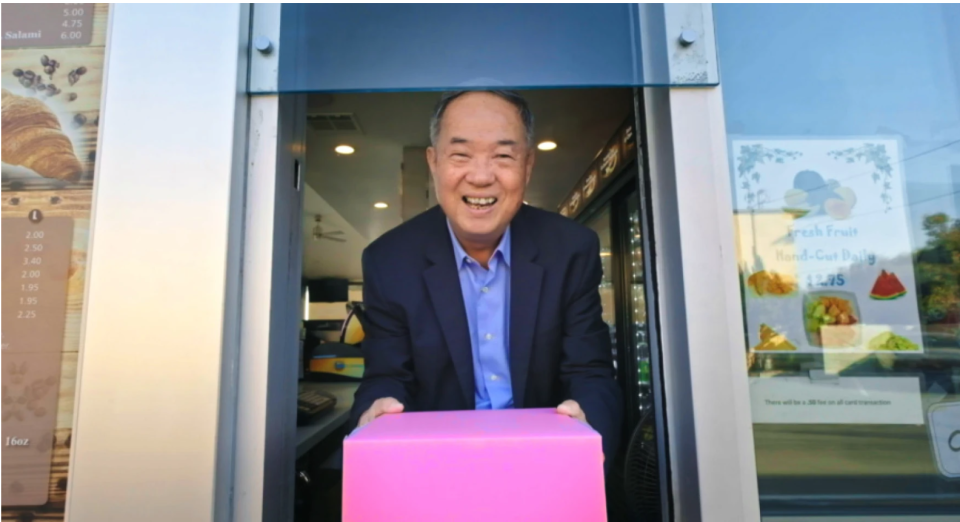Truth matters. Community matters. Your support makes both possible. LAist is one of the few places where news remains independent and free from political and corporate influence. Stand up for truth and for LAist. Make your year-end tax-deductible gift now.
How LA became a donut town and the man who started it all

At the turn of the 21st century, L.A. was the donut capital of the world, with more donut shops per capita than any other city.
Even now, if you take a stroll, there’s a good chance you’ll pass a small mom-and-pop on many street corners.
But how did donuts become such an integral part of L.A.’s urban landscape?
Well, what if I told you that many current donut shops in L.A. and Orange County can be traced back to just one man.
The man, the myth, the Donut King

In 1975, Ted Ngoy found himself in Camp Pendleton, California, after boarding the last passenger plane out of Cambodia to escape the Khmer Rouge.
Ngoy was part of the first wave of Cambodian refugees to come to the United States as their homeland fell into civil war and genocide.
In Southern California, Ngoy worked three jobs to earn money. One of them was at a gas station that just so happened to be attached to a donut shop.
One night, a co-worker offered Ngoy a donut. He took one bite of the fluffy fried dough and his American Dream was cemented.
As the story goes, Ngoy walked right into the donut shop and asked to buy the place. He was promptly laughed at and told to get a job at Winchell’s — which he did.
“Winchell's had this incredible manager training program, and you could go in, learn to bake donuts, learn the very basics, and within about three, six months, you would be handed the keys to your donut shop,” Alice Gu told guest host Austin Cross on LAist’s live public affairs program AirTalk with Larry Mantle. Gu is the filmmaker behind the documentary, The Donut King, which tells the story of Ngoy.
Gu said Ngoy soon became the manager of a Winchell’s in Newport Beach, but he still wasn’t satisfied.
After saving enough money, he eventually went back to the shop where it all began and made good on his original offer. A year later he bought another shop, and then another one.
“It's the complete embodiment of the American spirit and the American dream,” said Gu. “Within three years of landing in California he became a millionaire.”
A castle on every corner
He wanted to share that wealth with his community.
Ngoy wound up sponsoring many Cambodians who came to the United States during the second refugee wave in the late 70s, and he taught them what he knew: donuts.
“He accumulated all these donut shops, but then he would lease them back to them, so they had a chance at the American Dream themselves,” Gu said.
What started out as helping relatives and close friends became an entire niche industry for the Cambodian community.
“So every single donut shop is connected through six degrees of separation to Ted Ngoy,” Gu said.

A family affair
A cousin of Ngoy started the company B&H that supplied the flour, sugar, and other goods to the donut shops. Another launched a company to manufacture the iconic pink boxes that Ngoy popularized, said Gu.
Why pink boxes? They were 10 cents cheaper than the standard white ones.
“It really became a complete industry within the Cambodian American community,” Gu said. “At his peak, [Ngoy] estimated that he was worth about 20 million. That's actually closer to a hundred million dollars in today's money.”
The king and all his 'donut kids'
“Ted Ngoy was a celebrity,” said Phung Huynh, an artist and educator in Los Angeles. “He was really a superstar for us, seeing somebody who escaped the genocide and was able to make it.”
Huynh heard about Ted Ngoy all the way in Michigan, where her family landed in 1978 after her father fled the Khmer Rouge by riding a bicycle across the border to Vietnam.
“Like many Cambodian refugees, we all wanted to go to California,” said Huynh. “You hear about Ted Ngoy, you hear about all the refugee communities from Cambodia and Vietnam going to California.”

In 1981, Huynh and her family moved to L.A.
Many in her immediate family became garment workers, but their lives were still inextricably linked to donuts.
“It was very common for a lot of aunties and uncles and family friends to either work in a donut shop or lease a donut shop. That was just like really a part of the culture,” said Huynh.

Now Huynh focuses her art that speaks to second and third generation Cambodian Americans, the self-anointed “donut kids” whose parents operated the stores. She paints portraits of Cambodian refugees on the pink donut boxes that have defined so many of their lives.
“I think when you go to a donut shop, you see happy people greeting you with these donuts but behind the counter is this really complicated history of genocide, of war, of the younger generation finding their place and sometimes being very disconnected and reconnected with their history,” she said.
It’s donuts all the way down
If you’re wondering which shop you can find the Donut King behind the counter now, you’ll be looking for a while.
Gu said after making his fortune, Ngoy developed a gambling problem and lost every penny — and every one of his shops.
“One by one, he literally bet the shops, and one by one, he lost all of his donut shops. It really was quite Shakespearean, or Icarus, if you will,” Gu said.
He now lives in Cambodia, retired from the donut shop business.
But his legacy continues as second and third generation “donut kids” continue to propel their family businesses into the 21st century.
For example, you can visit DK Donuts in Santa Monica, ran by Ngoy’s niece Mayly Tao for some four decades. Now, she operates Donut Princess LA, where the menu includes more trendy flavors and vibrant decorations, but Ngoy’s story can still be tasted in every bite.








